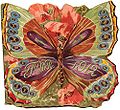 Twelfth Night Revelers Pin 2009 | |
| Abbreviation | TNR |
|---|---|
| Named after | Twelfth Night |
| Formation | January 6, 1870 |
| Founder | Sidney Smith |
| Type | Carnival Krewe |
| Location |
|
The Twelfth Night Revelers (TNR), founded in 1870, is a New Orleans, Louisiana, Carnival Krewe. It is the second oldest continuous organization of New Orleans Carnival festivities. [1]














